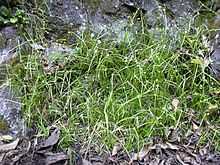Kyllinga
| Kyllinga | |
|---|---|
 | |
| Kyllinga nemoralis | |
| Scientific classification | |
| Kingdom: | Plantae |
| (unranked): | Angiosperms |
| (unranked): | Monocots |
| (unranked): | Commelinids |
| Order: | Poales |
| Family: | Cyperaceae |
| Genus: | Kyllinga Rottb. |
| Species | |
|
40-50, see text | |
| Synonyms[1] | |
| |
Kyllinga is genus of flowering plants in the sedge family known commonly as spikesedges. They are native to tropical and warm temperate areas of the world, especially tropical Africa.[1][2][3] These sedges vary in morphology, growing to heights from 2 centimeters to a meter and sometimes lacking rhizomes. They are closely related to Cyperus species.[4]
The genus was named for the 17th century Danish botanist Peder Lauridsen Kylling.
Species include:
- Kyllinga brevifolia
- Kyllinga coriacea
- Kyllinga erecta
- Kyllinga exigua
- Kyllinga gracillima
- Kyllinga melanosperma
- Kyllinga nemoralis
- Kyllinga odorata
- Kyllinga planiculmis
- Kyllinga polyphylla
- Kyllinga pumila
- Kyllinga squamulata
- Kyllinga tibialis
- Kyllinga triceps
- Kyllinga vaginata
References
- ↑ 1.0 1.1 Kew World Checklist of Selected Plant Families
- ↑ Flora of China, Vol. 23 Page 246, 水蜈蚣属 shui wu gong shu, Kyllinga Rottbøll, Descr. Icon. Rar. Pl. 12. 1773.
- ↑ Flora of North America, Vol. 23 Page 7, 193, Kyllinga Rottbøll, Descr. Icon. Rar. Pl. 12, plate 4, fig. 3. 1773.
- ↑ Govaerts, R. & Simpson, D.A. (2007). World Checklist of Cyperaceae. Sedges: 1-765. The Board of Trustees of the Royal Botanic Gardens, Kew.